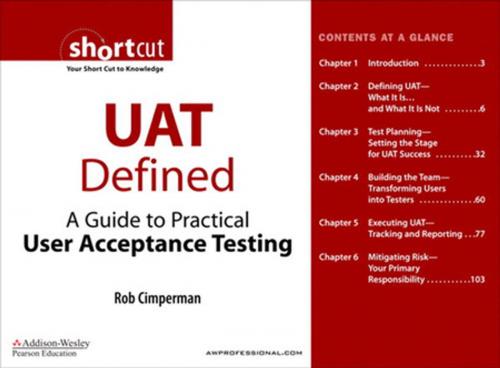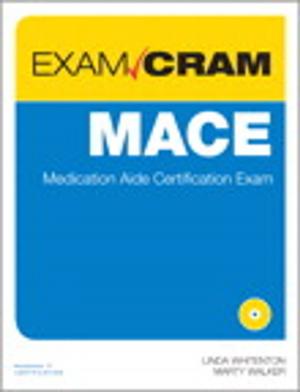UAT Defined
A Guide to Practical User Acceptance Testing (Digital Short Cut)
Nonfiction, Computers, Programming, Software Development| Author: | Rob Cimperman | ISBN: | 9780132702621 |
| Publisher: | Pearson Education | Publication: | November 28, 2006 |
| Imprint: | Addison-Wesley Professional | Language: | English |
| Author: | Rob Cimperman |
| ISBN: | 9780132702621 |
| Publisher: | Pearson Education |
| Publication: | November 28, 2006 |
| Imprint: | Addison-Wesley Professional |
| Language: | English |
This is the eBook version of the printed book.
This digtial Short Cut provides a concise and supremely useful guide to the emerging trend of User Acceptance Testing (UAT). The ultimate goal of UAT is to validate that a system of products is of sufficient quality to be accepted by the users and, ultimately, the sponsors. This Short Cut is unique in that it views UAT through the concept that the user should be represented in every step of the software delivery lifecycle--including requirements, designs, testing, and maintenance--so that the user community is prepared, and even eager, to accept the software once it is completed.
Rob Cimperman offers an informal explanation of testing, software development, and project management to equip business testers with both theory and practical examples, without the overwhelming details often associated with books written for "professional" testers. Rather than simply explaining what to do, this resource is the only one that explains why and how to do it by addressing this market segment in simple, actionable language. Throughout the author’s considerable experience coordinating UAT and guiding business testers, he has learned precisely what testers do and do not intuitively understand about the software development process. UAT Defined informs the reader about the unfamiliar political landscape they will encounter. Giving the UAT team the tools they need to comprehend the process on their own saves the IT staff from having to explain test management from the beginning. The result is a practice that increases productivity and eliminates the costs associated with unnecessary mistakes, tedious rework, and avoidable delays.
Chapter 1 Introduction
Chapter 2 Defining UAT–What It Is…and What It Is Not
Chapter 3 Test Planning–Setting the Stage for UAT Success
Chapter 4 Building the Team–Transforming Users into Testers
Chapter 5 Executing UAT–Tracking and Reporting
Chapter 6 Mitigating Risk–Your Primary Responsibility
This is the eBook version of the printed book.
This digtial Short Cut provides a concise and supremely useful guide to the emerging trend of User Acceptance Testing (UAT). The ultimate goal of UAT is to validate that a system of products is of sufficient quality to be accepted by the users and, ultimately, the sponsors. This Short Cut is unique in that it views UAT through the concept that the user should be represented in every step of the software delivery lifecycle--including requirements, designs, testing, and maintenance--so that the user community is prepared, and even eager, to accept the software once it is completed.
Rob Cimperman offers an informal explanation of testing, software development, and project management to equip business testers with both theory and practical examples, without the overwhelming details often associated with books written for "professional" testers. Rather than simply explaining what to do, this resource is the only one that explains why and how to do it by addressing this market segment in simple, actionable language. Throughout the author’s considerable experience coordinating UAT and guiding business testers, he has learned precisely what testers do and do not intuitively understand about the software development process. UAT Defined informs the reader about the unfamiliar political landscape they will encounter. Giving the UAT team the tools they need to comprehend the process on their own saves the IT staff from having to explain test management from the beginning. The result is a practice that increases productivity and eliminates the costs associated with unnecessary mistakes, tedious rework, and avoidable delays.
Chapter 1 Introduction
Chapter 2 Defining UAT–What It Is…and What It Is Not
Chapter 3 Test Planning–Setting the Stage for UAT Success
Chapter 4 Building the Team–Transforming Users into Testers
Chapter 5 Executing UAT–Tracking and Reporting
Chapter 6 Mitigating Risk–Your Primary Responsibility















